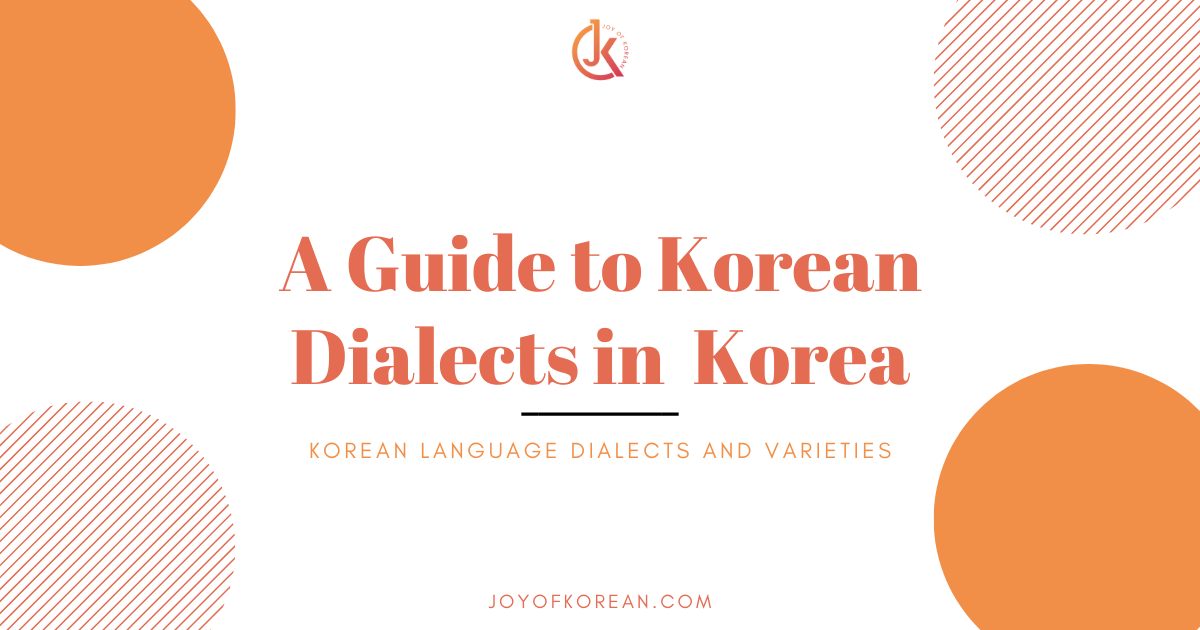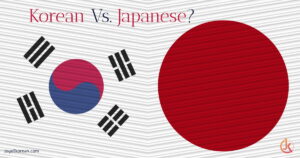Whether you study Korean to watch K-drama and K-pop or want to get a career in Korean, you may be unaware of the diverse K-varieties.
For most Korean learners outside Korea, Korean seems to be a uniform language with little to no variation across the peninsula.
You would be amazed by the vast linguistic diversity of the Korean language. It extends across North and South Korea, challenging the common perception of the same tongue.
That’s right!
The Korean language is a treasure trove of diversity. Today, it boasts a variety of regional varieties and creoles, each with its own unique charm and waiting to be explored.
Koreanic is a small language family with Korean and Jeju. Most call Jeju a Korean dialect, but it is mutually unintelligible with mainland Korean types.
A dialect isn’t a distinct language or accent. It is still the same language spoken by a specific class or community in a particular region. There are often some variations in terms of words, grammar, sound, and usage.
Almost all languages have some dialects, like Quebecian or Parisian French, British or American English, or Spanish of Madrid or Buenos Aires.
Many are mutually intelligible, so most can understand each other regardless of their dialects. The Korean language is no exception.
Table of Contents
- Why are there so many Korean dialects?
- Different Varieties of Korean Dialects
- Final Words: Which Korean dialects should you learn?
Why are there so many Korean dialects?
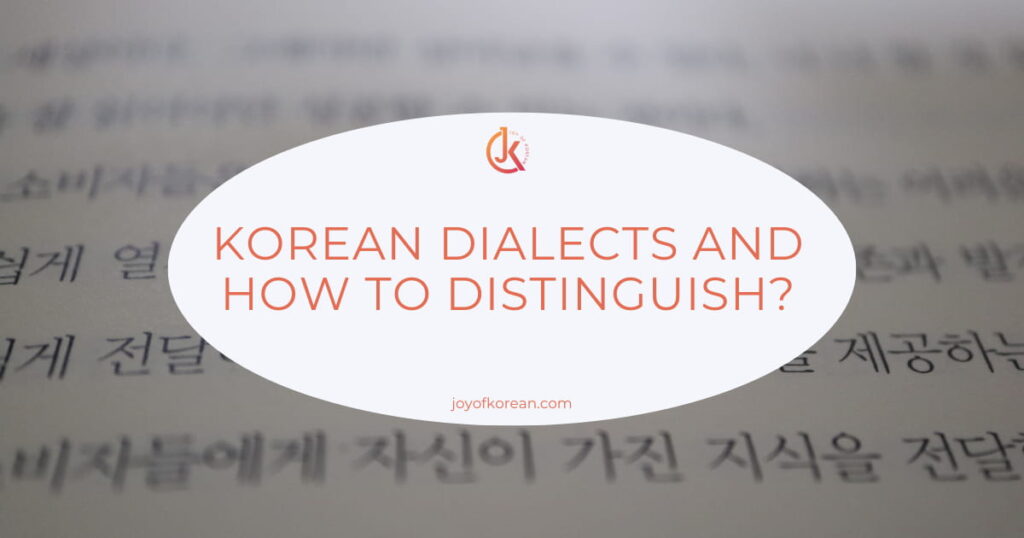
Most dialects exist in widely spoken languages like English, Arabic, Hindi, French, Mandarin, Spanish, and Portuguese.
However, Korean isn’t a commonly spoken tongue. Nearly 95% of natives, or 76 million speakers, live in two small North and South Korean countries.
The diverse dialects and characteristics of the Korean language are due to several factors. This involves both nations’ geography, history, isolation, and cultural diversity.
The mountains of Korea acted as barriers. It restricted interaction between various groups of people.
Because of this seclusion, separate dialects evolved in different regions. These lingoes echoed local culture, customs, traditions, and past.
The areas along the coast and islands like Jeju had even less contact with the mainland, leading to an even more distinct vernacular.
Korea previously had many kingdoms, like Goguryeo, Baekje, and Silla. Each had unique cultural and linguistic traits. The growth of regional speech patterns reflects past divisions, which are visible in today’s dialects.
Another reason is the lack of standardization in modern times. Before the 20th century, a standardized version of Korean didn’t exist, so each region had its own distinctive dialect.
The overall promotion of a unified Korean language only happened after the introduction of Standard Korean. It is based on the Seoul lingo.
The North and South divisions are other top reasons for this variation.
After 1945, the division of Korea made dialectal contrasts more obvious. Political, cultural, government policies, isolation, and social changes in the North and South have guided different language use.
Each variety is a unique story that reflects the people and places of origin. As an outcome, many Korean dialects live today.
To learn Korean, one must become familiar with the subtle variations in its many dialects, known as 방언 or 사투리. Understanding these nuances is vital for mastering the language and fully appreciating its rich diversity.
Different Varieties of Korean Dialects
Let’s start by learning the two broad categories of Korean dialects: North Korean and South Korean.
The Korean Language Society proposed “Unified Korean Orthography” in 1933 for both Koreas.
But, since the creation of the DPRK and ROK in 1948, both nations have followed different language policies. The decades of separation have now made a noticeable disparity between North and South Korean Koreans.
Let’s dive deep into it.
A. Korean dialects in South Korea
There are six main dialects of South Korean, each representing a region in South Korea: Gyeonggi, Gyeongsang, Chungcheong, Gangwon, Jeolla, and Jeju.
Let’s find it.
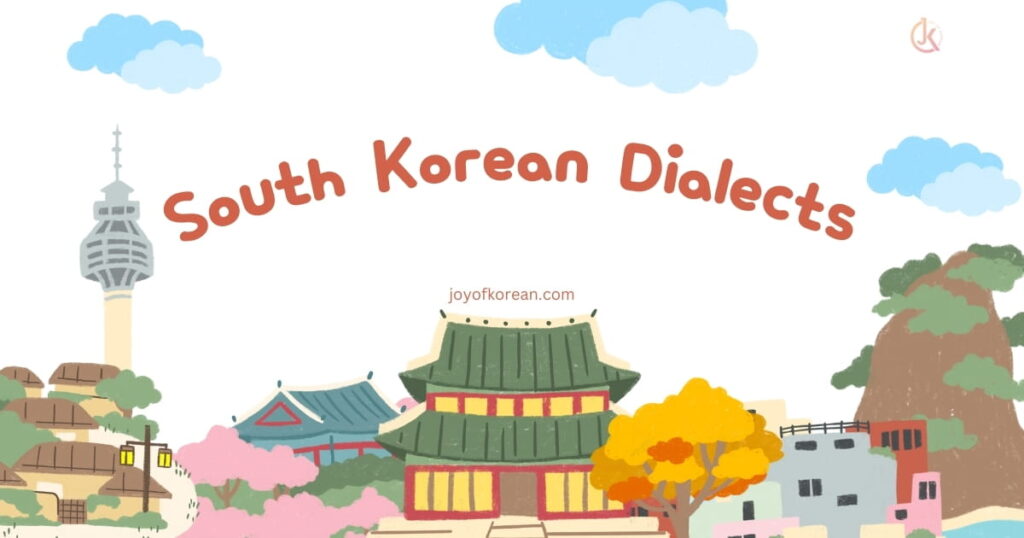
1. Seoul Dialect (서울 사투리; 서울말) / Gyeongi (경기 방언)
The Gyeonggi dialect, also known as the Seoul dialect, is recognized as the most standard form of Korean and a commonly used way of speaking. It closely resembles 표준어, the official form of the Korean language.
This is the standard Korean dialect. If you study Korean for any reason, you’ll learn this variety. It is used widely in TV, public speech, media, official documents, and education.
While primarily spoken in Gyeonggi Province, Seoul, and Incheon cities, this dialect can be understood by almost everyone in South Korea.
This dialect is standard but differs in sound, words, and use.
Key Features of Gyeonggi /Seoul Dialect
- It has clear, smooth, and neutral pronunciation. This makes it the most intelligible dialect of Korean.
- There is minimal regional variation in the vowels and consonants.
- It has a softer and more balanced intonation than Gyeongsang (harsh) or Jeolla (musical).
- At the end of some words, the vowel 아 sounds like 어.
- Polite speech endings like -요 (-yo) and formal endings like – 습니다 (- seumnida) are common.
E.g., “What are you doing?” — “뭐 하세요?” (Mwo haseyo?) - This dialect uses a vocabulary similar to that found in South Korean textbooks, media, and official documents. Unlike other regional dialects, it does not have unique or local words.
- People often see it as casual, polite, and formal. This makes it suitable and flexible for various situations and social settings.
2. Gyeongsang Dialect (경상도 방언)
The Gyeongsang dialects (Southeastern Korean) originate from the historical region of Gyeongsang Province.
This area is now divided into Daegu, Busan, Ulsan, North, and South Gyeongsang Province. It is one of the most recognizable and distinct Korean dialects.
The dialects of the three cities, Busan, Ulsan, and Daegu, differ slightly, with the Busan variant being the most famous.
Key Features of Gyeongsang Dialect
- It has an energetic, fast intonation with a rougher sound. Tones and pitch are used more prominently, making it different. For example, the verb “있다” (to exist) may have a distinct pitch than the standard dialect of Gyeonggi.
- Unlike Standard Korean, which uses stress and rhythm, this one has a pitch accent system.
- Words that are spelled the same can have different meanings based on their pitch. For example, 말 (mal) spoken with a high pitch means “speech,” while 말 (mal) spoken with a low pitch means “horse.”
- The vowelsㅐ(ae) and ㅔ(e) are often mixed in standard, but it’s evident in this dialect.
Example: 내 (nae) (“I”) and 네 (ne) (“you”) are pronounced in a way that is easy to tell apart. - Common words and phrases are shortened, which creates a fast-paced way of speaking.
Example: Standard: “왜 그래?” (Wae geurae?) Gyeongsang: “와 그러노?” (Wa geureono?). - It often uses informal particles like -노 and -가. It adds a chatty and assertive tone.
Example: “맞다 아이가?” (Mata aiga?): “That’s right, isn’t it?” - The endings -노 (-no) and -가 (-ga) are typical, replacing -요 (-yo).
Example: Standard: “뭐 해요?” (Mwo haeyo?) Gyeongsang: “머하노?” (Meo hano?). - Negative constructions can vary slightly from those in Standard.
Example: 못 (mot) (Standard) becomes 몬 (mon) in Gyeongsang.
3. Jeolla Dialect (전라도 방언)
The Jeolla dialect (Southwestern Korean) is spoken in the Jeolla (Honam) region of South Korea. This includes the metropolitan city of Gwangju.
This area was called Jeolla Province during the Joseon era. Much like the Chungcheong dialect, the Jeolla lacks official standard status. Pansori text is written using the Jeolla version.
To learn more about the Jeolla dialect, I suggest watching the movie “Sunset in My Hometown.”
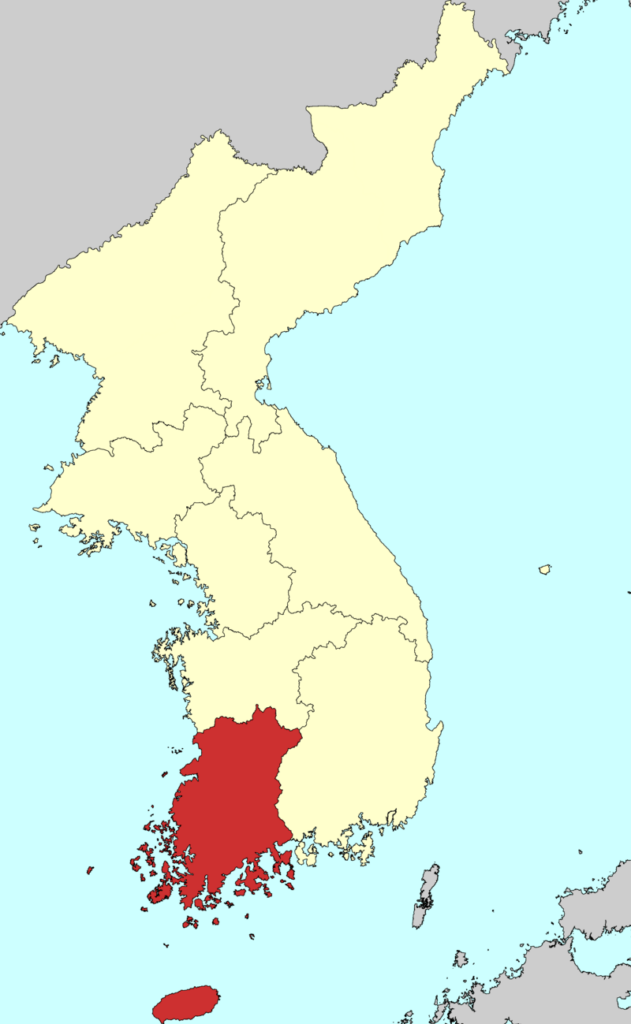
Key Features of Jeolla Dialect
- This is fast, but not as quick as the Seoul dialect. It is less dynamic and intense than the Gyeongsang one, but it still makes speakers sound enthusiastic and funny.
- The Jeolla one is more informal and has pleasant expressions.
- It has a softer and more melodic intonation and a stronger focus on vowel sounds. Certain sentence endings, such as “~잉” and “~쥬,” are unique features.
Example: “먹었어?” (Did you eat?) — “머겄어잉?” - The final syllables of sentences are often long, making the sound more casual and friendly.
- It has -잉 (-ing) as a sentence-ending particle. It shows focus and friendliness. Example: Standard: “괜찮아요?” (Gwaenchanayo?) Jeolla: “괜찮잉?” (Gwaenchang-ing?)
- Casual ends like -라잉 (-raing) and -그라잉 (-geuraing) are typical.
Example: Standard: “알았어요.” (Arasseoyo.) Jeolla: “알았당께~” (Arattangke~.) - It has unique words that set it apart from others.
Examples:
“어떻게?” (Eotteoke?) — Jeolla: “어쩐당가?” (Eojjeondangga?): How?
“그지요?” (Geuji-yo?) — Jeolla: “그잖아잉?” (Geujana-ing?): Isn’t that right? - Phrases such as “당께” (dangke), which means “so” or “thus,” are expected of the Jeolla dialect.
- Verb endings are simple.
Example: Standard: “뭐 하세요?” (Mwo haseyo?) Jeolla: “머 혀?” (Meo hyeo?)
4. Chungcheong Dialect (충청도 방언)
Chungcheong is primarily spoken in the Chungcheong province in the west-central region, including the large city of Daejeon.
The Chungcheong dialect has two major categories: the Northern, similar to Gyeonggi, and the Southern, akin to Jeolla.
This variety of Korean is calm and modest. People in this area often speak slower and seem friendlier than elsewhere.
Key Features of Chungcheong Dialect
- It is noted for a slower speech rate, vowel changes, unique terms, relaxed speech pattern, and wide pitch range.
- A unique feature is the powerful word 뭐여 (mwoyeo), which can be used in almost any situation.
- Distinct sentence endings like “~유” are common. Standard: “맞아요.” (Majayo.) Chungcheong: “맞아유.” (Majayyu.)
- The endings -슈 (-syu) and -여 (-yeo) are regular to make a more friendly tone. Example: Standard: “뭐 하세요?” (Mwo haseyo?) Chungcheong: “뭘 혀유?” (Mweol hyeoyyu?)
- Declarative sentences often end with a rising pitch. It looks like questions to speakers of other dialects.
Example: Standard: “그렇죠.” (Geureochyo.) Chungcheong: “그렇슈?” (Geureosyu?) - It makes some verb forms simpler and sounds casual.
Example: “해야 돼요.” (Haeya dwaeyo) — “혀야 되유.” (Hyeoya dweeyyu). - Many local words and phrases exist:
“저기요” (Jeogiyo) → “어유” (Eoyu): Hey there / Excuse me.
“그렇지요?” (Geureochijyo?) — “그렇슈?” (Geureosyu?): Isn’t that right?
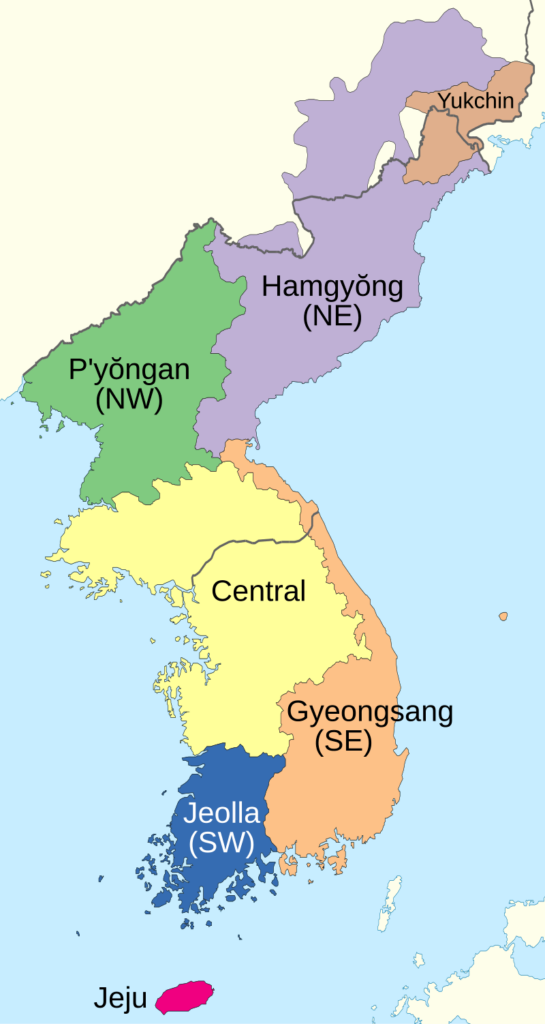
5. Gangwon Dialect (강원도 방언)
The Gangwon dialect is spoken in the province of Gangwon in South Korea and Kangwŏn in North Korea. These provinces are immense, but they have relatively fewer populations.
This area is known for many mountains and forests. Because of centuries of isolation, they developed their own dialect. In 2018, the Pyeongchang Olympic Games took place in this province.
The dialect resembles Seoul’s but includes a unique vocabulary, mainly in mountainous regions. Older forms may also influence more remote areas.
Key Features of Gangwon Dialect
- The cadence rises slightly at the end of the sentences, adding a questioning or warm tone.
- ㅆ (ss) sounds like ㅅ (s).
- At the end of a sentence,ㅏ changes to ㅓ.
- At the sentence end, the standard 아 (ah) sound changes to 어 (eo).
- Questions can also end in 나 (na), -노 (no), -고 (go), -가 (ga).
- The suffix -다리 is used to express assurance or force.
Example: Standard: “맞아요.” (Majayo.) Gangwon: “맞다리.” (Majdari.) - End -구만 is used to agree, like “Oh, I see” in English.
Example: Standard: “그렇구나.” (Geureokuna.) Gangwon: “그렇구만.” (Geureokuman.) - Like others, it can be simplified or changed.
Example: Standard: “뭐 하고 있어요?” (Mwo hago isseoyo?) Gangwon: “뭐 혀?” (Mwo hyeo?) - The dialect has a casual and friendly tone. It reflects the easygoing nature of people in Gangwon.
6. Korean dialects in Jeju Dialect (제주어 / 제주 방언)
The Jeju dialect, also known as the Jeju language (제주어), is a unique and highly distinct variety of Korean. It is spoken on Jeju Island off the southern coast of South Korea.
Many linguists consider it a distinct language because of the significant differences between Jeju, standard, and other regional dialects.
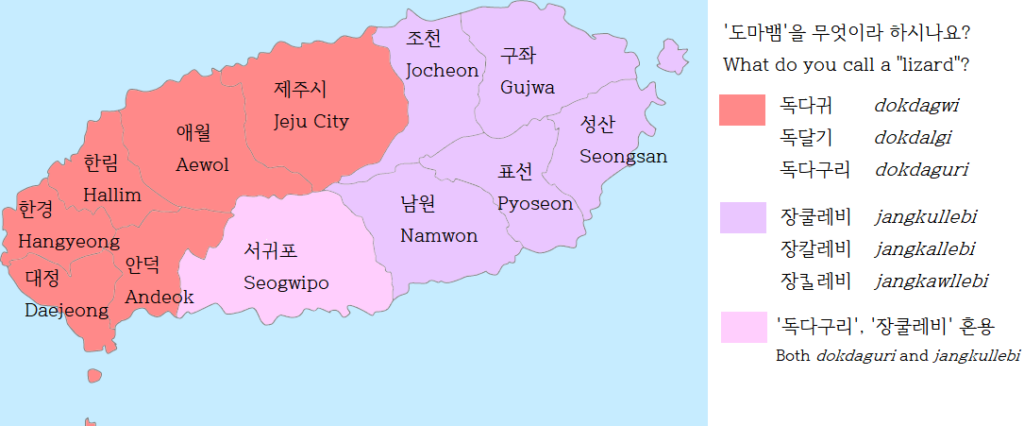
Key Features of Jeju Dialect
- Pronunciation differs vastly. Some consonants and vowels are softened, while others reflect older forms of Korean.
Standard Korean: “무엇” (mueot) → Jeju: “무사” (musa) for “what” or “why.” - The vocabulary and grammar are unique, shaped by past interactions with other areas and languages.
Example: “어디 가세요?” (Where are you going?) → “어디 감수광? - This honorific ending is unique to Jeju to show respect.
Example: Standard: “하세요?” (Haseyo?) Jeju: “햄수꽈?” (Haem-sukwa?) - The ending -염 is commonly used to add a sociable tone.
Example: Standard: “먹어요.” (Meogeoyo.) Jeju: “먹어염.” (Meogoyeom.) - Jeju-eo boasts a vast, unique vocabulary, unlike any other dialect.
Examples: “하르방” (Hareubang): Grandfather, “멍에” (Meong-e): Cow’s harness, “궷다” (Gwetta): To dig up. - It keeps grammatical structures and markers from Middle Korean.
Example: Standard: “있어요.” (Isseoyo.) Jeju: “이시다.” (Isida).
B. Korean dialects in North Korea
Today, North Koreans and South Koreans can easily communicate. This is because the main languages of the two countries mostly come from a 1936 document by the Korean Language Society.
Korean dialects in North Korea can be grouped by region. They are like South Korean dialects but have unique qualities due to various factors over many decades.
Here’s an overview of the major dialects in North Korea.
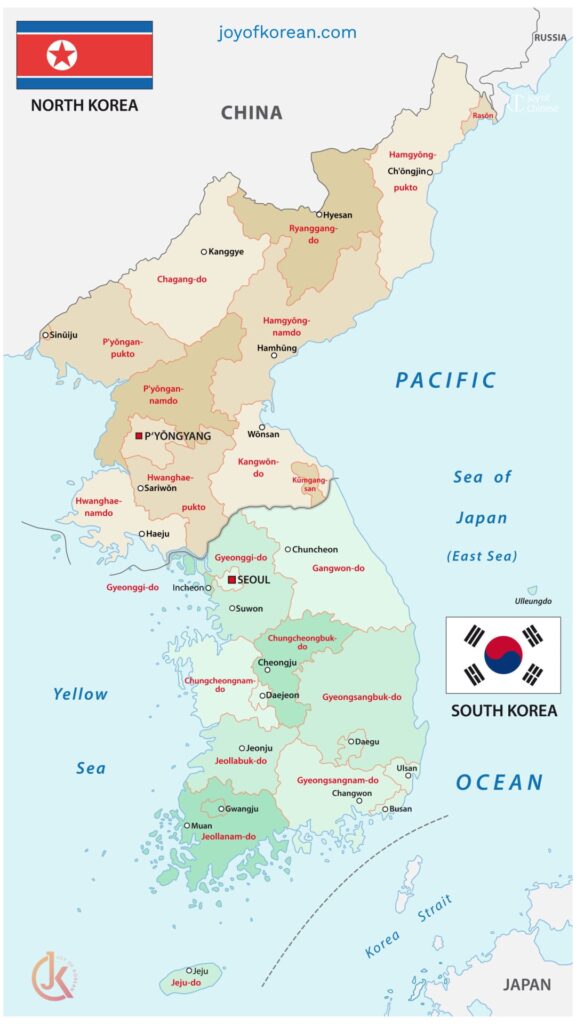
7. Pyongan Dialect (평안 방언)
Pyongan Dialect (also known as Northwestern or Munhwaŏ / 문화어) is the standardized form of Korean and the official language of the Democratic People’s Republic of Korea (DPRK).
It is extensively used in Pyongyang, North and South Pyongan, and Chagang Province. It is also helpful in Yanbian and other neighboring Chinese regions.
The core ideologies and government policies have vastly influenced it. This dialect is common in education and media.
Key Features of Pyongan (Munhwaŏ) Dialect
- It uses a unique vocabulary and expression not found in South Korea but is affected by local traditions and socialist principles.
E.g., Computer (전자계산 / 컴퓨터) and Hand Phone (핸드폰 / 손전화). - This has a simpler intonation and pronunciation than Seoul Koreans. This one has many Sino-Korean characters.
For instance, (why) 왜 – 외, (cold water) 연냉수 – 랭수, and (girl) 여자 – 녀자. - Unlike the Jeolla and Gyeongsang dialects, the Pyongan one lacks melodic intonation.
- Certain sounds differ. Vowel “ㅓ” (eo), which may sometimes sound closer to “ㅗ” (o). “ㄹ” (r/l) at the end of syllables may sound more apparent. It also omits or softens “ㅎ” (h) in everyday speech.
- Verb endings are often shorter or distinct
Standard: “-아요/-어요” (-ayo/-eoyo) — Pyongan: “-오” (-o).
Example: Standard: “괜찮아요.” (Gwaenchanayo.) Pyongan: “괜찮소.” (Gwaenchanso.) - South Koreans use many foreign loanwords and Konglish (Korean English). Because of North Korea’s isolation, Pyongyang takes a more conventional approach, reinforcing the use of words of Korean origin. That is why it has fewer foreign words.
8. Hwanghae Dialect (황해도 방언)
The Hwanghae dialect is helpful in the Hwanghae region, which includes Hwanghae (North Korea), South Korea’s Gyeonggi Province, and Incheon.
The Hwanghae region is close to the North and South Korean border. It mirrors both Pyeongan and Gyeonggi dialects and has features from both North and South Korean languages.
This makes it somewhat distinct from other colloquial spoken further to the south in South Korea, like the Gyeongsang or Jeolla dialects.
Its distinct pronunciation, unique accents and intonation, vocabulary, and certain grammatical elements set it apart from standard Korean.
Key Features of Hwanghae Dialect
- Some consonants and vowels vary slightly from standard Korean. Vowels like “ㅏ” and “ㅓ” can sound more open.
- Many words differ from others, creating difficulties in contact between speakers from different regions. It uses unique words influenced by regional history and culture.
- Subtle grammatical differences, such as sentence endings, particles, and verb forms, may differ from standard Korean.
- Frequent use of -소 (-so) in polite and formal speech.
Example: Standard: “하세요.” (Haseyo.) Hwanghae: “하소.” (Haso.) - Use of -라우 (-rau): A formal yet commanding tone.
Example: Standard: “앉으세요.” (Anjuseyo.) Hwanghae: “앉으라우.” (Anjurau.) - Addition of -네라 (-nera) for gentle emphasis.
Example: Standard: “그렇군요.” (Geureokunyo.) Hwanghae: “그렇네라.” (Geureonera.) - Verb endings are often shorter or more casual.
Example: Standard: “-지 않아요” (-ji anhayo) → Hwanghae: “-지 않소” (-ji anso)
9. Hamgyong Dialect (함경 방언)
Hamgyong (known as Northeast) is another dialect in the north and south Hamgyŏng and Ryanggang provinces of northeastern North Korea. Because of Korea’s division, you will rarely hear about it in South Korea.
This variant is known for its distinctive linguistic features.
Key Features of Hamgyong Dialect
- This dialect tends toward nasalization, giving it a sharp, strong, and unique sound. The vowels /ㅓ/ (eo) and /ㅗ/ (o) often differ from other dialects.
- For example, “없다” (eopda, meaning “to not exist”) might sound with a slightly altered vowel tone. These have distinct consonants and are more aspirated or emphatic than in standard Korean.
- It has its own verb endings and particles that differ from other dialects. For example, in Hamgyong, people use the polite ending “라요” (ra-yo) rather than the standard Korean ending “세요” (see).
- It has many unique words related to food, clothing, and farming. Since it is close to Russia and China, mainly the neighboring Jilin, it has loanwords or sound influences from these languages.
- Contrary to the softer tones of central dialects, this has a harsher or more abrupt pitch. The speech patterns are often clipped, giving it a unique rhythm.
- It uses some uncommon forms of consonant doubling, especially for intensity in speech.
Example: “밝다” (balgda) becomes “빨르다” (ppallda) in some areas.
Final Words: Which Korean dialects should you learn?
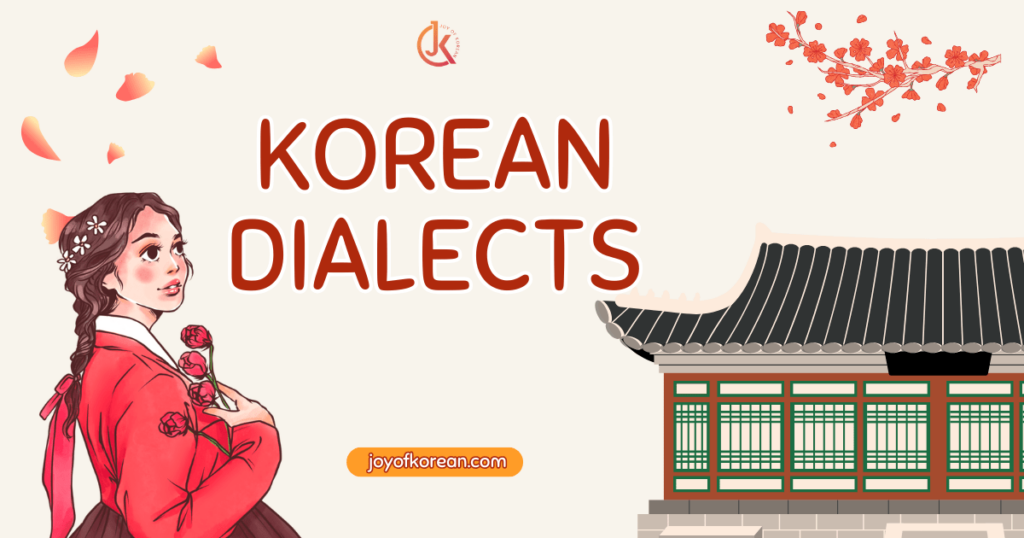
Most Korean students, particularly beginners, needn’t worry about learning various Korean dialects. Knowing the standard (Seoul dialect) is enough to communicate effectively nationwide.
Seoul is the only official standard, although there are nine Korean varieties in North and South Korea. The Pyongan (Munhwaŏ) is the official in North Korea, which is not so different from Seoul (Gyeonggi).
Learning regional dialects can be helpful, depending on your goals and interests. If you intend to live in those parts or work with them, it can vastly deepen your connection with Korean culture and communities.
Each Korean type is unique, and some are difficult to grasp. Yet, most people understand each other without problems. This is because of the high mutual intelligibility between dialects.
I hope this post has helped you identify the most popular Korean dialects and what sets them apart.
If you want to share your thoughts, share them in the comment section below.
